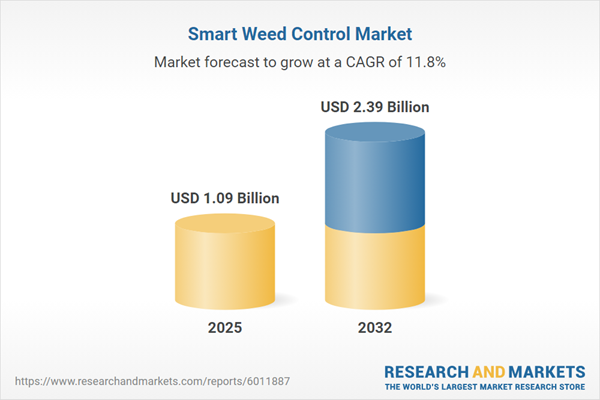Speak directly to the analyst to clarify any post sales queries you may have.
Senior decision-makers in agriculture and turf management are re-evaluating their approach to weed control as digital innovation and automation usher in a new era of operational efficiency and strategic agility. The smart weed control market offers integrated solutions that align industry objectives with evolving regulatory standards and sustainability imperatives.
Market Snapshot: Smart Weed Control Market—Growth Trajectory
The smart weed control market is on a robust upward trajectory, driven by the widespread adoption of automation, IoT sensors, and cloud-based intelligence platforms. As agricultural and turf-focused organizations respond to increasing labor costs and shifting compliance landscapes, new technologies—such as robotics and machine-vision-enabled interventions—have accelerated the industry’s shift away from manual processes. This dynamic environment supports organizations seeking to elevate operational outcomes and adapt to more sophisticated, multifaceted regulatory requirements, while maintaining a competitive edge across key markets.
Scope & Segmentation: Key Investment Insights in Smart Weed Control
For executives exploring investment, market entry, or strategic expansion, this report details the essential domains shaping innovation and integration within the smart weed control sector. Key areas include:
- Product Types: Ground robots, robotic mowers, UAV sprayers, maintenance services, monitoring tools, fleet management software, and weed detection applications designed to streamline activities in agricultural fields and turf management scenarios.
- Technologies: Assisted GPS, RTK GPS, 2D/3D vision systems, and soil sensors form the technical foundation, ensuring precision and reliability across diverse environments and deployment models.
- Applications: Horticulture, row crop oversight, and routine turf maintenance (including golf courses and sports venues) all benefit from platforms that deliver targeted, environment-specific weed control.
- End Users: Commercial farms, landscaping providers, and turf care enterprises, both large and small, find adaptable solutions that meet unique operational and resource demands.
- Deployment Modes: Public and private cloud infrastructures, edge processing units, and on-premises installations enable organizations to tailor integration based on security and connectivity preferences.
- Components: Robotic arms, vehicle or UAV mounts, precision nozzles, hyperspectral and optical imaging, LiDAR, and advanced cameras combine to enable rapid detection and precise intervention when and where needed.
- Power Sources: Diesel, battery, solar-powered, and hybrid systems address the energy needs of urban, rural, and remote deployment scenarios for maximum flexibility.
- Regions: North America, South America, Europe, the Middle East, Africa, and Asia-Pacific each play a unique role in shaping adoption and growth, with attention to local regulatory frameworks and workforce dynamics.
- Key Companies: Deere & Company, Bayer AG, BASF SE, Syngenta International AG, Corteva Agriscience, AGCO Corporation, CNH Industrial N.V., Trimble Inc., Topcon Corporation, and Kubota Corporation are among the principal drivers of technological progress in this space.
The integration of analytics, automation, and robotics allows organizations to align smart weed control solutions with both global standards and local requirements.
Key Takeaways for Senior Decision-Makers
- Industry priorities are shifting from traditional herbicide approaches to more targeted, data-driven weed management models to enhance compliance and support sustainability goals.
- Deployment of IoT-enabled sensors and real-time data analytics enables early detection capabilities, empowering organizations to improve resource planning while minimizing unnecessary interventions.
- Cloud and edge infrastructure models provide organizations with the ability to synchronize distributed teams and adapt efficiently to variable site or operational needs.
- Integrated and modular hardware-software platforms simplify oversight and support rapid, evidence-based decision-making at multiple organizational levels.
- Flexible IT strategies ensure organizations can maintain seamless continuity, enabling adaptability to evolving regulatory expectations or shifts in market focus.
- Adoption of advanced digital weed control systems supports improved efficiency, resilience, and compliance outcomes across operationally diverse regions.
Tariff Impact: Adapting Supply Chain and Market Tactics
Adjustments in global trade and tariff frameworks compel organizations to reassess sourcing channels within the smart weed control supply chain. Transitioning to nearshore partnerships and diversifying supplier networks strengthens both technology continuity and service delivery, reinforcing market stability even as international trade dynamics evolve.
Methodology & Data Sources
This report consolidates perspectives from executive interviews, peer-reviewed studies, industry-focused research, and patent analysis. All findings are validated by sector experts, providing a foundation that is directly relevant to C-suite strategy initiatives.
Why This Report Matters
- Delivers senior leaders the impartial insights necessary for confident technology selection, risk mitigation, and compliance planning in the smart weed control sector.
- Enables organizations to recognize and act on operational and market opportunities, as well as sector challenges, in both established and developing geographic regions.
- Offers rigorously vetted research to guide informed decisions for organizational investment and operational enhancement.
Conclusion
Advancements in smart weed control equip organizations to keep pace with industry changes, embed sustainability, and enhance competitive readiness within agriculture and turf management sectors.
Additional Product Information:
- Purchase of this report includes 1 year online access with quarterly updates.
- This report can be updated on request. Please contact our Customer Experience team using the Ask a Question widget on our website.
Table of Contents
3. Executive Summary
4. Market Overview
7. Cumulative Impact of Artificial Intelligence 2025
Companies Mentioned
The companies profiled in this Smart Weed Control market report include:- Deere & Company
- Bayer AG
- BASF SE
- Syngenta International AG
- Corteva Agriscience
- AGCO Corporation
- CNH Industrial N.V.
- Trimble Inc.
- Topcon Corporation
- Kubota Corporation
Table Information
| Report Attribute | Details |
|---|---|
| No. of Pages | 184 |
| Published | November 2025 |
| Forecast Period | 2025 - 2032 |
| Estimated Market Value ( USD | $ 1.09 Billion |
| Forecasted Market Value ( USD | $ 2.39 Billion |
| Compound Annual Growth Rate | 11.8% |
| Regions Covered | Global |
| No. of Companies Mentioned | 11 |









